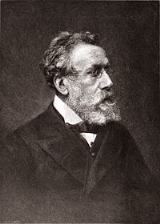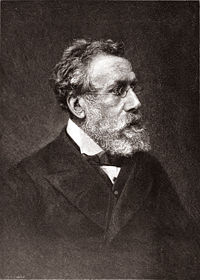
Andrew Ramsay
Encyclopedia

Scotland
Scotland is a country that is part of the United Kingdom. Occupying the northern third of the island of Great Britain, it shares a border with England to the south and is bounded by the North Sea to the east, the Atlantic Ocean to the north and west, and the North Channel and Irish Sea to the...
geologist
Geologist
A geologist is a scientist who studies the solid and liquid matter that constitutes the Earth as well as the processes and history that has shaped it. Geologists usually engage in studying geology. Geologists, studying more of an applied science than a theoretical one, must approach Geology using...
.
Biography
Ramsay was born at GlasgowGlasgow
Glasgow is the largest city in Scotland and third most populous in the United Kingdom. The city is situated on the River Clyde in the country's west central lowlands...
, being the son of William Ramsay, manufacturing chemist
Chemist
A chemist is a scientist trained in the study of chemistry. Chemists study the composition of matter and its properties such as density and acidity. Chemists carefully describe the properties they study in terms of quantities, with detail on the level of molecules and their component atoms...
. He was for a time actually engaged in business, but from spending his holidays in Arran
Isle of Arran
Arran or the Isle of Arran is the largest island in the Firth of Clyde, Scotland, and with an area of is the seventh largest Scottish island. It is in the unitary council area of North Ayrshire and the 2001 census had a resident population of 5,058...
he became interested in the study of the rocks of that island, and was thus led to acquire the rudiments of geology
Geology
Geology is the science comprising the study of solid Earth, the rocks of which it is composed, and the processes by which it evolves. Geology gives insight into the history of the Earth, as it provides the primary evidence for plate tectonics, the evolutionary history of life, and past climates...
. A geological model of Arran, made by him on the scale of two inches to the mile, was exhibited at the meeting of the British Association at Glasgow in 1840, and attracted the notice of Roderick Murchison
Roderick Murchison
Sir Roderick Impey Murchison, 1st Baronet KCB DCL FRS FRSE FLS PRGS PBA MRIA was a Scottish geologist who first described and investigated the Silurian system.-Early life and work:...
, with the result that he received from Henry De la Beche
Henry De la Beche
Sir Henry Thomas De la Beche FRS was an English geologist and palaeontologist who helped pioneer early geological survey methods.-Biography:...
an appointment on the Geological Survey
British Geological Survey
The British Geological Survey is a partly publicly funded body which aims to advance geoscientific knowledge of the United Kingdom landmass and its continental shelf by means of systematic surveying, monitoring and research. The BGS headquarters are in Keyworth, Nottinghamshire, but other centres...
, on which he served for forty years, from 1841 to 1881.
He was first stationed at Tenby
Tenby
Tenby is a walled seaside town in Pembrokeshire, South West Wales, lying on Carmarthen Bay.Notable features of Tenby include of sandy beaches; the 13th century medieval town walls, including the Five Arches barbican gatehouse ; 15th century St...
, and to that circumstance may be attributed the fact that so much of his geological work dealt with Wales
Wales
Wales is a country that is part of the United Kingdom and the island of Great Britain, bordered by England to its east and the Atlantic Ocean and Irish Sea to its west. It has a population of three million, and a total area of 20,779 km²...
. His first book, The Geology of the Isle of Arran, was published in 1841. In 1845 he became local director for Great Britain
Great Britain
Great Britain or Britain is an island situated to the northwest of Continental Europe. It is the ninth largest island in the world, and the largest European island, as well as the largest of the British Isles...
, but he continued to carry on a certain amount of field-work until 1854. To the first volume of the Memoirs of the Geological Survey (1846) he contributed a now classic essay, On the Denudation of South Wales and the Adjacent Counties of England, in which he advocated the power of the sea to form great plains of denudation, although at the time he underestimated the influence of subaerial
Subaerial
The term subaerial is mainly used in geology to describe events or structures that are located at the Earth's surface...
agents in sculpturing the scenery. In 1866 he published The Geology of North Wales (vol. iii. of the Memoirs), of which a second edition was published in 1881.
He was chosen as a professor of geology at University College, London, in 1848, and afterwards as a lecturer in the same subject at the Royal School of Mines
Royal School of Mines
Royal School of Mines comprises the departments of Earth Science and Engineering, and Materials at Imperial College London.- History :The Royal School of Mines was established in 1851, as the Government School of Mines and Science Applied to the Arts...
in 1851. Eleven years later he was elected to the presidential chair of the Geological Society of London
Geological Society of London
The Geological Society of London is a learned society based in the United Kingdom with the aim of "investigating the mineral structure of the Earth"...
, and in 1872 he succeeded Murchison as director-general of the Geological Survey. In 1880 he acted as president of the British Association at Swansea
Swansea
Swansea is a coastal city and county in Wales. Swansea is in the historic county boundaries of Glamorgan. Situated on the sandy South West Wales coast, the county area includes the Gower Peninsula and the Lliw uplands...
, and in the following year retired from the public service, receiving at the same time the honour of knighthood. In 1860 he published a book entitled The Old Glaciers of Switzerland and North Wales. The study of this subject led him to discuss the Glacial Origin of Certain Lakes in Switzerland, the Black Forest, &c. He dealt also with the origin of The Red Rocks of England (1871) and The River Courses of England and Wales (1872).
He was especially interested in tracing out the causes which have determined the physical configuration of a district, and he devoted much attention to the effects produced by ice, his name being identified with the hypothesis, which, however, has never commanded general assent, that itt some cases lake basins have been scooped out by glacier
Glacier
A glacier is a large persistent body of ice that forms where the accumulation of snow exceeds its ablation over many years, often centuries. At least 0.1 km² in area and 50 m thick, but often much larger, a glacier slowly deforms and flows due to stresses induced by its weight...
s. A master in the broader questions of stratigraphy
Stratigraphy
Stratigraphy, a branch of geology, studies rock layers and layering . It is primarily used in the study of sedimentary and layered volcanic rocks....
and physical geology, he was a deal exponent of facts, but rather impatient of details, while his original and often bold theories, expressed both in lectures and in writings, stirred others with enthusiasm and undoubtedly exercised great influence on the progress of geology.
His lectures to working men, given in 1863 in the Museum of Practical Geology, formed the nucleus of his Physical Geology and Geography of Great Britain (5th ed., 1878; 6th ed., by H. B. Woodward, 1894). He received a Royal medal in 1880 from the Royal Society
Royal Society
The Royal Society of London for Improving Natural Knowledge, known simply as the Royal Society, is a learned society for science, and is possibly the oldest such society in existence. Founded in November 1660, it was granted a Royal Charter by King Charles II as the "Royal Society of London"...
, of which he became a fellow in 1862; he was also the recipient of the Neil prize of the Royal Society of Edinburgh
Royal Society of Edinburgh
The Royal Society of Edinburgh is Scotland's national academy of science and letters. It is a registered charity, operating on a wholly independent and non-party-political basis and providing public benefit throughout Scotland...
in 1866, and of the Wollaston medal
Wollaston Medal
The Wollaston Medal is a scientific award for geology, the highest award granted by the Geological Society of London.The medal is named after William Hyde Wollaston, and was first awarded in 1831...
of the Geological Society of London in 1871. He died at Beaumans.

